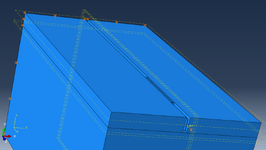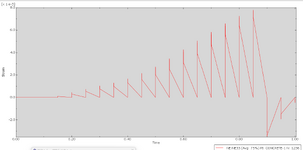I'm currently working on a numerical simulation of a Near-Surface-Mounted (NSM) FRP reinforcement in concrete using ABAQUS. I'm trying to simulate fiber pull-out behavior using the Cohesive Zone Model (CZM) approach to model the bond between the FRP and the epoxy adhesive.
 I’ve also attached a reference image of the model setup.
I’ve also attached a reference image of the model setup.
I'm observing a weird zig-zag pattern in the strain distribution along the bonded region of the FRP, especially near the epoxy interface. Instead of a smooth increase or gradient, the strain results are jagged and oscillatory.
Yet, the zig-zag strain profile still persists, and it’s affecting the interpretation of bond behavior and pull-out force.
I’m looking for serious suggestions or feedback from anyone who:
Is this a mesh sensitivity issue? Do I need to modify the cohesive law (like add viscosity or softening regularization)? Could the load application be too abrupt even with a smooth step?
Any help would be appreciated!


 Model Overview
Model Overview
- Geometry: A concrete block with a groove made at the top mid-region (centered along the width).
- FRP rod/strip: Placed inside the groove.
- Bonding: The FRP is bonded to the surrounding concrete through an epoxy adhesive layer, where the cohesive elements are used to simulate the bond interface.
- Loading: A displacement-controlled load is applied to the free end of the FRP (pull-out direction).
- Boundary Conditions: The back face of the concrete block is fully fixed in the loading direction.
 The Issue
The Issue
I'm observing a weird zig-zag pattern in the strain distribution along the bonded region of the FRP, especially near the epoxy interface. Instead of a smooth increase or gradient, the strain results are jagged and oscillatory.
 What I’ve Tried So Far:
What I’ve Tried So Far:
- Applied Smooth Step Amplitude to the displacement to ensure gradual loading.
- Experimented with different boundary conditions and constraint combinations.
- Refined the mesh near the bonded zone.
- Double-checked material properties and cohesive behavior inputs.
- Tried increasing cohesive element resolution and checking the concrete-epoxy interface behavior.
Yet, the zig-zag strain profile still persists, and it’s affecting the interpretation of bond behavior and pull-out force.
 What I Need
What I Need
I’m looking for serious suggestions or feedback from anyone who:
- Has dealt with strain noise or instability in cohesive simulations.
- Can help identify potential modelling errors or overlooked issues.
- Might know if this is a numerical artifact, and if so, how to regularize or eliminate it.
Is this a mesh sensitivity issue? Do I need to modify the cohesive law (like add viscosity or softening regularization)? Could the load application be too abrupt even with a smooth step?
Any help would be appreciated!


